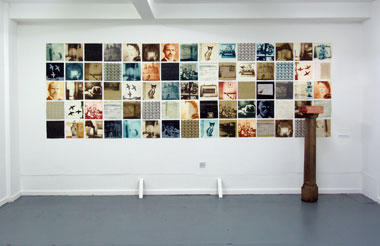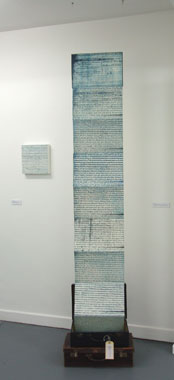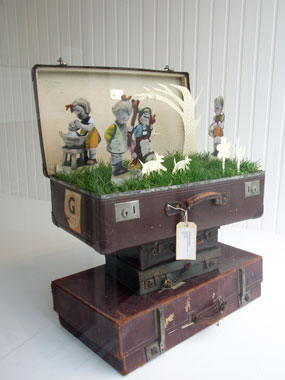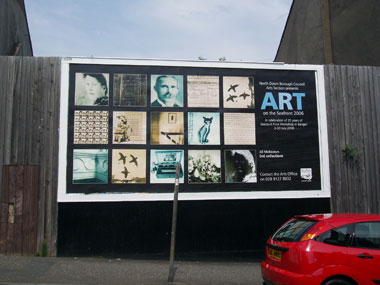 |
| Jill McKeown: All that and those, 2006, assemblage of accordion format book, etching and glass jars of ephemera |
Jill McKeown makes images using her skills of printmaking and installation. The artworks relate to familiar activities: most people collect things, bring home memorabilia of experiences and events, tell stories about them, and come across a suitcase or a box full of old photographs or letters covered with the dust of time. Anyone searching for a history of anything realizes how important material documents are and how difficult it often is to locate them. McKeown elected to make the collector a prototype of how she develops her art practice. She collects objects, natural and man made, an activity hastened by her childhood home being scheduled for redevelopment. This exhibition harvests elements from her earlier life in celebration of the past.
 |
| Jill McKeown: And then I remembered II, 2006, photo-intaglio monoprint, 26 x 26 cm; photo / courtesy the artist |
In the context of Northern Ireland culture, the past has been put on the pedestal of a dictator – it determines the present and future of this society to a surprising extent because it seems to be a guarantor of security and identity. McKeown goes along with some of this ideology; however, as an artist she cannot but question the powerful role of the past. The strategy of severe selection, of honest authenticity, of quiet preciousness, all assist her autobiographical memories to become interpersonal.
 |
| Jill McKeown: Jeu de mémoire, 2006, wall installation of intaglio prints and etched copper box, 500 x 150 cm; photo / courtesy the artist |
Many artists work with the same subject. Memory was, for example, a supreme subject of the exhibition Exploratorium (1998 – 9), in which a San Francisco Bay self-taught artist, Franco Magnani, juxtaposed his painting from memory of his birthplace with photographs by Susan Schwartzenberg taken there in 1987. The accuracy of Magnani’s memory was extraordinary, yet, he was surprised to see three windows on the house he painted, from memory, with one. Omission, distortion and accuracy are all components of memory.
.jpg) |
| Jill McKeown: Jeu de mémoire (detail), 2006, wall installation of intaglio prints and etched copper box, 500 x 150 cm; photo / courtesy the artist |
The works of art exhibited here embody the aura of found objects; however, they are not made from memory but as a memory.
 |
| Jill McKeown: Stone and bones, 2006, accordion format book of photo etchings and four prints on block, blocks 26 x 26 cm; photo / courtesy the artist |
For example: McKeown photographed glass flowers in a Boston museum and printed them as three images overlapping each other, like a multiple exposure done by mistake. The result is a poetic image as if of a natural, not a man made, form. By making each image transparent and accommodating another, the result abandons descriptions. It increases the feeling of the presence of the flower being just under the surface of the print in the haze of the gentle mist. A convincing lie, as Picasso called the proper business of art.
.jpg) |
| Jill McKeown: Lease (detail), 2006, assemblage of accordion format book of etchings, suitcase and horseshoes; block 26 x 26 cm; photo / courtesy the artist |
Researchers in psychology recognise several mental processes that pertain to memory, among them levelling and sharpening . Some of the flowers are levelled into the misty ground; some are sharpened onto the plane, nearer to the eye. The fading of accuracy, a decay of memory traces, present in this image, is further worked into another work of art, the long written scroll Lease, displayed above a suitcase into which it will return after its brief escape.
.jpg) |
| Jill McKeown: Lease (detail) and To have and to hold (block on wall), 2006, assemblage of accordion format book of etchings, suitcase and horseshoes; block 26 x 26 cm; photo / courtesy the artist |
People cherish objects as memorabilia, especially in late-life reminiscences. The artist has selected cut-out dolls, placed them in an open suitcase on a turf of grass for the same reason, thinking of her childhood. One component of memory has been identified as assimilation, pairing of familiar and unfamiliar, expected and unexpected. McKeown fuses her memory of playing with china ornaments on the mantelpiece with the interference of move, change, travel in time and space; hence the suitcase.
 |
| Jill McKeown: Lease and To have and to hold (block on wall), 2006, assemblage of accordion format book of etchings, suitcase and horseshoes; block 26 x 26 cm; photo / courtesy the artist |
The set of old suitcases confirms collecting as a part of this art practice; moreover they illustrate another mental process connected to memory, blending . Blending several different experiences into a coherent image governs several works of art on display here: suitcases become pedestals and containers, but also are given their own voice flattened onto a vertical print. The tower of suitcases happily escapes the association with shop display; instead the stories of past travels may be imagined, in this joyful portrayal of surreal, floating of suitcases within old wallpaper. The optical playfulness of this image is endearing and enriching in how it blends real and unreal, known and unexpected.
 |
| Jill McKeown: On the mantelpiece, 2006, assemblage of photo-intaglio print cut-outs, suitcases and grass; photo / courtesy the artist |
The irregularities our memory so generously showers us with are, perhaps surprisingly, advantageous; first, they lessen the burden of the past by making it vulnerable; second they organically invite their opposite, regularity, in this case a grid. The grid has been favoured by all significant contemporary artists. McKeown endows the grid with a fresh take on repetition, on variants of events, by interfering with old images: she has reprinted each in several different hues. Adorable vividness of recognition is one of the rewards.
collection-3.jpg) |
| Jill McKeown: (re)collection III, 2006, photo-intaglio print with chine colle, 57 x 37 cm; photo / courtesy the artist |
The personally meaningful sources, when they become a work of art, develop and maintain intimacy and, paradoxically, elicit empathy from others. They generate ideas, speculations, questions, and interrelations – all aspects of the social function of memory. In this way the personal becomes social.
collection-4.jpg) |
| Jill McKeown: (re)collection IV, 2006, photo-intaglio print with chine colle, 57 x 37 cm; photo / courtesy the artist |
If one art relates to another, like words to an image, we speak of ecphrasis, a rhetorical vividness. In the early history of our civilisation, ecphrasis was applied to things, persons and even experiences. This exhibition revives that range of ecphrasis by mobilising both the primary sources and the whimsies of imagination. McKeown adopts the model which the classical philosopher Socrates made famous: even if removed from the actual house, time, place, suitcase full of old remnants of somebody’s life, her images define those existences anew and allow us to view them.
 |
| Jill McKeown: Jeu de mémoire, 2006, billboard to mark Seacourt Print Workshop 25 years anniversary; photo / courtesy the artist |
Slavka Sverakova is a freelance writer on art.